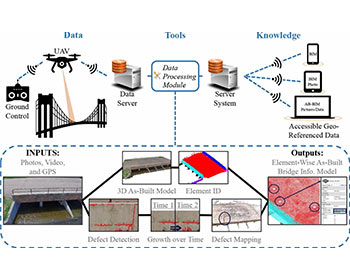Papers by MPC Researchers at Colorado State Published
Posted: Oct 9, 2020
 Work by MPC researchers at Colorado State University was recently published in several journals.
Work by MPC researchers at Colorado State University was recently published in several journals.
"Streamlined bridge inspection system utilizing unmanned aerial vehicles and machine learning," by Brandon J. Perry, Yanlin Guo, Rebecca Atadero and John W. van de Lindt was published in the journal, Measurement. This paper proposes a streamlined bridge inspection system that offers advanced data analytics tools to automatically identify and map bridge defects. This system allows bridge managers to better leverage UAV technologies in bridge inspection and conveniently monitor the health of a bridge through quantifying and visualizing the progression of damage for each structural element.
"Probabilistic modeling of disrupted infrastructures due to fallen trees subjected to extreme winds in urban community," by Guangyang Hou and Suren Chen, was published in the journal, Natural Hazards. The researchers developed a methodology to model the performance of infrastructures disrupted by fallen urban trees in a typical community that had been subjected to extreme winds. They used the model to predict the probabilities of powerline disruption, road closure, and origin-destination disconnection and travel time reliability under different wind conditions.
"Hybrid nonlinear seismic analysis of bridges with moving traffic," by Luke Chen, Yufen Zhou, and Suren Chen, was published in the Journal of Aerospace Engineering. The researchers developed a methodology to capture the complex dynamic interactions between bridges and multiple vehicles as well as nonlinear seismic performance to predict how bridges will perform when subjected to moving vehicles and earthquakes. The work was based on MPC project 461.
"Finite-Element Model of Impact Loading and Deformation of a Flexible Steel Ring-Net Debris-Flow Barrier," by Aliena Debelak, Christopher Bareither, and Hussam Mahmoud, was published in the journal Natural Hazards Review. Flexible steel ring-net structures are used for debris-flow mitigation in mountainous terrain. Although these structures have been shown effective in geohazard mitigation, their design does not incorporate coupled interactions between debris-flow mechanics and stress-strain response of the steel structure. Thus, the researchers developed a finite-element model to simulate the coupled behavior encountered in a flexible debris-flow mitigation structure.